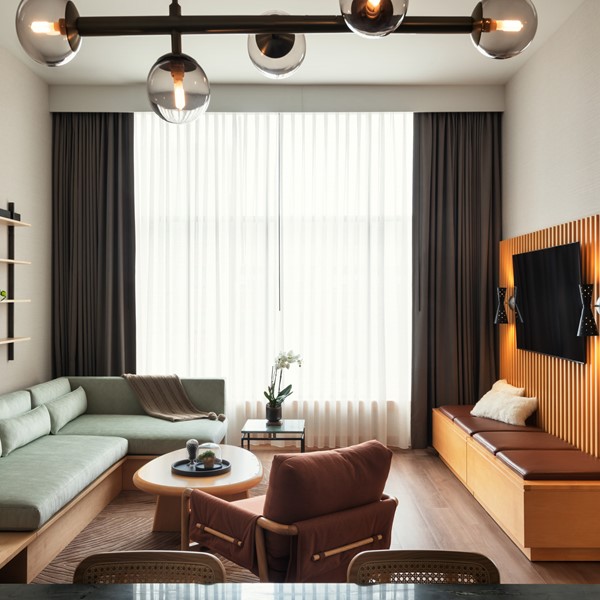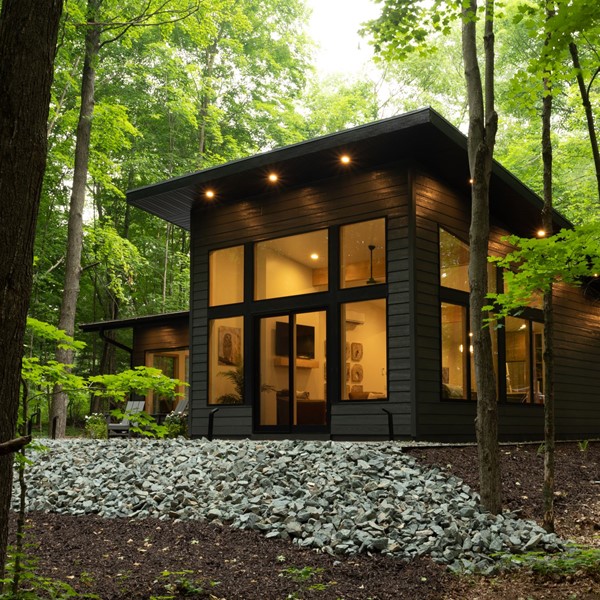
20 Fascinating Historical Sites That Tell the Story of Wisconsin
Wisconsin’s past is made up of all kinds of people and stories, from ancient mound builders to European immigrants to authors, performers, freedom-seekers and many more. Feel the past come alive and deepen your understanding of the present by adding any of these fascinating historical sites to your next Wisconsin outing.
Aztalan State Park - Jefferson

Visit one of the oldest historic landmarks in Wisconsin by exploring Aztalan State Park, just a thirty-minute drive east of Madison. This archaeological site is home to the ruins and artifacts of an ancient middle Mississippian village that is thought to have thrived from 1000 to 1300 AD. Historians then believe it was abandoned, about 200 years before Columbus landed in America.
As you wander between restored burial mounds and reconstructed towering log walls, you’ll be able to feel the deep history within this National Historic Landmark. Follow interpretive signs along the way to learn more about Native American history and this piece of Wisconsin’s fascinating past.
Basilica of St. Josaphat - Milwaukee
One of just two basilicas in Wisconsin, St. Josaphat was designed to be a smaller version of the iconic St. Peter’s Basilica in Rome, though to this day it is still the largest church in Milwaukee. Construction finished in 1901, followed by years of oil mural painting, ornamental plasterwork and installation of stained glass windows. In 1929, Pope Pius XI declared St. Josaphat an official basilica, an honor reserved for the largest, most beautiful and most historically important churches. At the time, it was only the third Basilica in the United States and the first Polish-American church with this honor.
Stop in the visitor center to find information for a self-guided tour or a guided one. The grounds are all wheelchair accessible so everyone in your group can marvel at the remarkable structure that’s now over 120 years old and an important part of both Milwaukee's and Wisconsin’s history.
Circus World Museum - Baraboo

More than 200 antique circus wagons—the largest collection in the world—make the Circus World Museum in Baraboo much more than just a place to see amazing animals, bumbling clowns and tightrope walkers. The museum’s collection of historic circus posters, handbills and costumes is extensive, too. In the library archives, you’ll find tons of American circus history, starting with materials from the first U.S. circus (in Philadelphia, 1793).
Why is it all here? These 50 acres were the original winter quarters for the one-and-only Ringling Bros. Circus. The entire site is a National Historic Landmark, as well as a place to see live circus performances in summer that enchant travelers just as they have for so many years.
First Capitol - Belmont
Since Wisconsin’s current capitol building is so grand and iconic, you may not know that the state’s first house of governance was actually located 50 miles southeast in the town of Belmont. Today, you can visit the First Capitol historic site where in 1836 representatives laid the foundation for our state.
Fort Crawford Museum - Prairie du Chien
What opened as a military hospital in 1831 has since become a fascinating place to learn about frontier methods of medical treatment. The fort surgeon, Dr. William Beaumont, conducted many experimental treatments here that helped found the modern study of medicine.
Wander recreated exhibits that include an 1850 doctor’s office, a 1900 dental office, an iron lung and much more. Also on the property is the Museum of Prairie du Chien, where your group can dive into even more history about the oldest European settlement on the Upper Mississippi River.
H.H. Bennett Studio and History Center - Wisconsin Dells
Before the work of Henry Hamilton Bennett, the stunning cliffs, crooks and caves of Wisconsin Dells were a well-kept secret known to few. Bennett’s knack with a camera changed all of that and helped turn Wisconsin Dells into a national tourist attraction.
The tools and results of Bennett’s work make for a wondrous collection at the H.H. Bennett Studio and History Center. He was an enterprising businessman as well as an artist, eventually selling pictures of tourists in front of steamboats as vacation souvenirs. Explore interactive exhibits including the same photo studio where families had their portraits taken in the 1800s.
Laura Ingalls Wilder Cabin - Pepin
Head to Pepin in Northwest Wisconsin to see where Laura Ingalls Wilder, author of “Little House on the Prairie”, was born in a humble cabin. Her book “Little House in the Big Woods” was set in this part of Wisconsin in the 1870s and told of the challenges of pioneer life. The classic has been translated into 40-plus languages and was the basis for a popular television series. Plan your visit for the second full weekend in September to take part in Laura Ingalls Wilder Days which includes traditional craft demonstrations, a fiddle contest, horse-drawn carriage rides and much more!
Little White Schoolhouse, Birthplace of the Republican Party - Ripon
This National Historic Landmark was built in 1850 and according to Congressional Record is the original birthplace of the U.S. Republican Party. The first meeting took place over 170 years ago when members of three existing political parties came together to fight against the spread of slavery.
Take a free tour of the museum to learn more about this legendary meeting place, the founding of Ripon and what school life was like for children of the 1800s.
Madeline Island Museum - LaPointe

A quick ferry ride from Bayfield is all that separates travelers from some of the oldest stories in Wisconsin’s history. The Madeline Island Museum celebrates all of the many cultures that have called the island home. From exhibits that delve into Ojibwe culture to an entire building dedicated to trade between the tribe and French missionaries to a barn built by a Swedish immigrant, there’s much to explore throughout the museum grounds.
Milton House Museum - Milton

Joseph Goodrich founded the village of Milton and seemed to set up much of it single-handedly. The first school classes were taught in his home. He organized the first church, served as the first postmaster, built the first blacksmith shop and lobbied the railroad to run a line through town. His hexagonal Milton House was a multi-purpose building: part hotel, part commercial enterprise, part apartments -- and part passageway for slaves to gain freedom from 1844 to 1867. In addition to his other roles, Goodrich was an Underground Railroad conductor, an abolitionist who helped freedom seekers escape slavery and find a new life in Canada.
Make your way through the Milton House Museum which includes many original structures including the same tunnel that served as part of the Underground Railroad. This National Historic Landmark offers guided tours and is the last authenticated stop on the Underground Railroad that can still be toured in Wisconsin.
National Railroad Museum - Green Bay
Did you know one of the nation’s largest railroad museums is located in Green Bay, Wisconsin? It sure is! Take a train tour of the museum’s 33 acres which includes Dwight Eisenhower’s World War II command train, the world’s largest steam locomotive, the 1950s Aerotrain and much more!
Plan your visit around the holidays to take the little ones on the Great Pumpkin Train or the Polar Express!
Old World Wisconsin - Eagle
Enter into many eras of the state’s past at Old World Wisconsin, where 60 authentically restored historic homes, farms, stores and workshops as well as costumed actors will transport you into another world. You’ll meet furry friends on the farms, enjoy old-fashioned soda water in the general store, see sparks fly in the blacksmith shop, see how beer is made and so much more. Learn the stories of Wisconsin’s immigrant past and come away with a deeper understanding of what life was like for these communities between the 1840s and 1910s.
Pabst Mansion - Milwaukee
Built by the famed brewing family between 1890 and 1892, the Pabst Mansion remains one of the largest and most expensive houses ever constructed in Milwaukee. Saved from demolition in 1975, it now sits on the National Register of Historic Places and has been restored to its former glory. Depending on the time of year you visit, choose from themed tours such as the adults-only brewing history tour (with a “cheers” to the captain), the Fine Art Tour, the Behind-the-Scenes Tour and tours in Spanish.
Pabst Theater - Milwaukee
Past and present come together within Milwaukee’s Pabst Theater, a National Historic Landmark that’s hosted performances by everyone from Katherine Hepburn and Louis Armstrong to The Backstreet Boys and Bon Iver.
Opened in 1895 after the first theater financed by Captain Frederick Pabst burned down, the structure was designed in the tradition of European opera houses. And for the first 20 years of its life, the venue was home to exclusively German-language productions. Because of declining revenue, however, the Pabst began scheduling English performances by 1918.
See a show at the Pabst Theater to get a glimpse of its 2-ton Austrian crystal chandelier, Italian marble staircase and gold leaf framing of the stage. As the fourth oldest continuously operating theater in the U.S., this Wisconsin gem is a must-visit.
Pendarvis - Mineral Point
During the 1830s and 1840s, Southwest Wisconsin was rapidly populated as miners came from across the United States and Europe to mine the region's abundant lead deposits. Several mining boomtowns sprang up in the region, including Mineral Point.
Many of these immigrants were from Cornwall, at the southwestern tip of Great Britain. Many of the Cornish immigrants built simple houses in the town using wood or limestone taken from the local landscape. When the mines began to run out, most of these families migrated west with the Gold Rush of 1849.
Bob Neal and Edgar Hellum met in 1934 and dedicated their lives to saving the structures and stories of Mineral Point’s mining history. The couple salvaged, restored and made these buildings shine again, even establishing a popular restaurant on the site to fund their preservation efforts. Today, you can still visit the charming Pendarvis neighborhood to sample Cornish meat pies called pasties, tour the historic trails and learn about this fascinating time in Wisconsin’s history.
Stonefield - Cassville
Located on the Great River Road at the foot of towering bluffs atop Nelson Dewey State Park, Stonefield Historic Site includes 30 historic shops and factories that transport you back in time to the streets of Wisconsin over 100 years ago. Explore a recreated newspaper office, cheese factory, bank, saloon and more to get a glimpse of what life was like in rural Wisconsin in the early 20th century.
While on the property, be sure to stop in at the State Agricultural Museum and rebuilt Gothic Revival mansion of Wisconsin’s first governor, Nelson Dewey.
Taliesin - Spring Green

Explore the extraordinary home of American architect, writer, musician and farmer Frank Lloyd Wright. Taliesin, Wright's residence, studio, school, and 800-acre estate is located in the Driftless Region of Southwest Wisconsin and includes buildings from nearly every decade of the architect's career, from the 1890s to the 1950s.
Wright appropriately named his Wisconsin residence "Shining Brow" in honor of his Welsh heritage. Taking inspiration from the surrounding hills and valley, he constructed a home in harmony with nature. Multiple wings and terraces frame the landscape to embrace the site from which Taliesin stands as "brow." Today, Taliesin is a National Historic Landmark (1974) and UNESCO World Heritage Site (2019). Visit to take a tour or even an immersive workshop to learn more about this iconic part of Wisconsin's history.
Ten Chimneys - Genesee Depot
The 60-acre summer retreat of legendary actors Alfred Lunt and Lynn Fontanne brought many other Broadway stars to the Midwest for R&R 75 years ago.
Take a one-of-a-kind tour of the magnificent property (a National Historic Landmark) east of Milwaukee to browse treasures such as notes from Laurence Oliver and Carol Channing, mementos from Helen Hayes and Noel Coward, inscribed first-edition books by Edna Ferber and mementos from Charlie Chaplin. For decades, this idyllic retreat inspired the country's finest actors, writers and artists. Now, let it inspire you!
USS Cobia - Manitowoc
What was life like inside of a submarine during World War II? Visit the Wisconsin Maritime Museum in Manitowoc to find out by taking a tour of the USS Cobia. Or, get an even deeper feel for the experience by spending the night in the submarine!
The restored sub is almost identical to the 28 that were constructed by the Manitowoc Shipbuilding Company during the war. The Cobia sank six Japanese vessels and earned four battle stars in conflict. Since 1970, it has been an international memorial to submariners worldwide.
Wade House - Greenbush
During the 1860s, people traveled via horse-drawn carriages between Sheboygan and Fond du Lac. This was a slow and probably uncomfortable journey, but there was a haven for rest at the midway point. This was the Wade House, a place to get a hearty meal and spend the night.
Now a state historic site, the property caters to travelers in a different way. Tours the stagecoach inn as well as the Wesley Jung Carriage Museum, home to Wisconsin’s largest wagon and carriage collection. Glimpse the Herrling sawmill, powered by water from the Mullet River, one of a rare few working water-powered mills of its kind in North America. And in the summer, time your visit to experience Civil War re-enactments and learn more about Wisconsin’s part in U.S. history.
Discover more fascinating Wisconsin stories (with then and now pictures) at these Wisconsin destinations with history.










